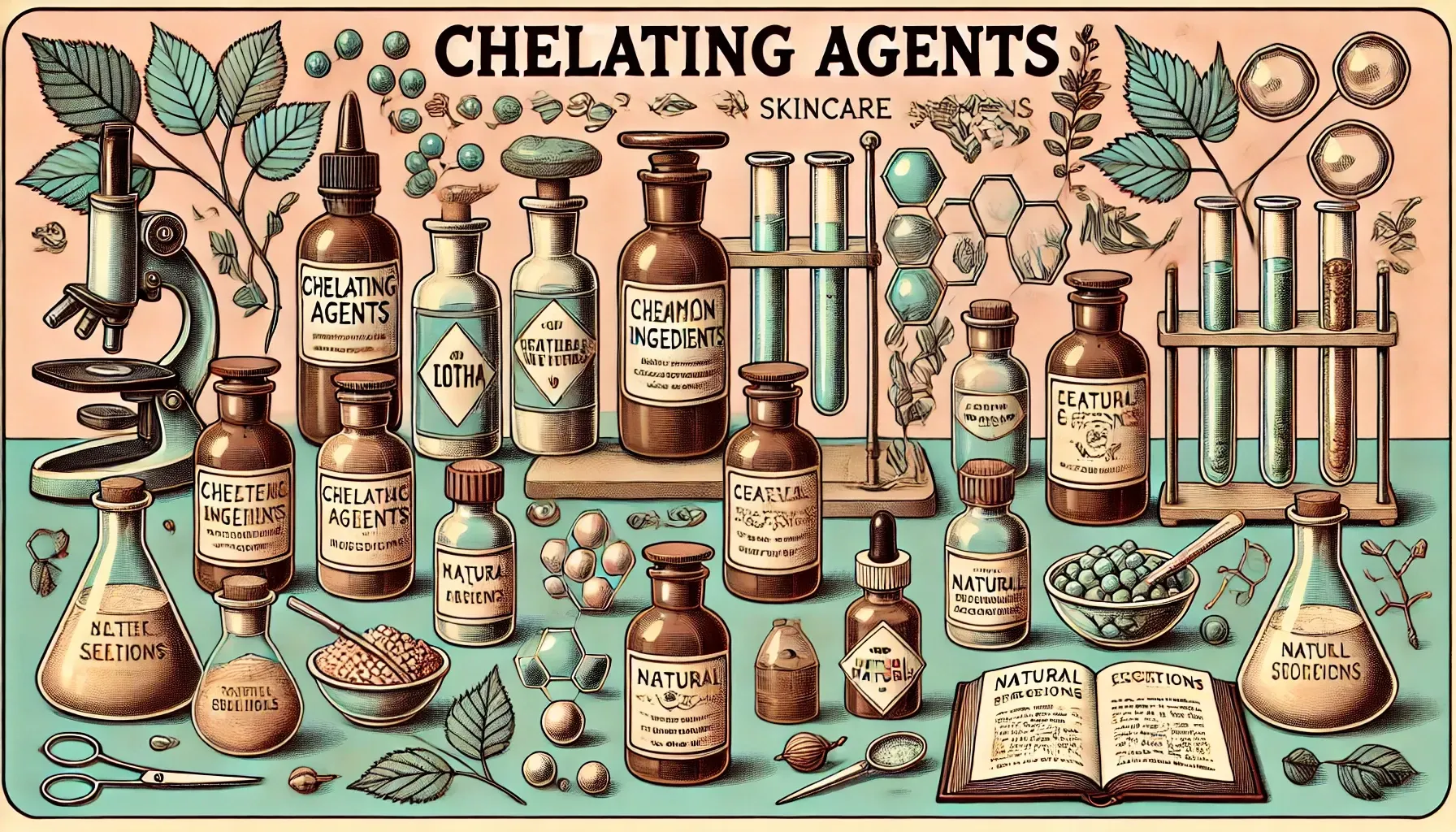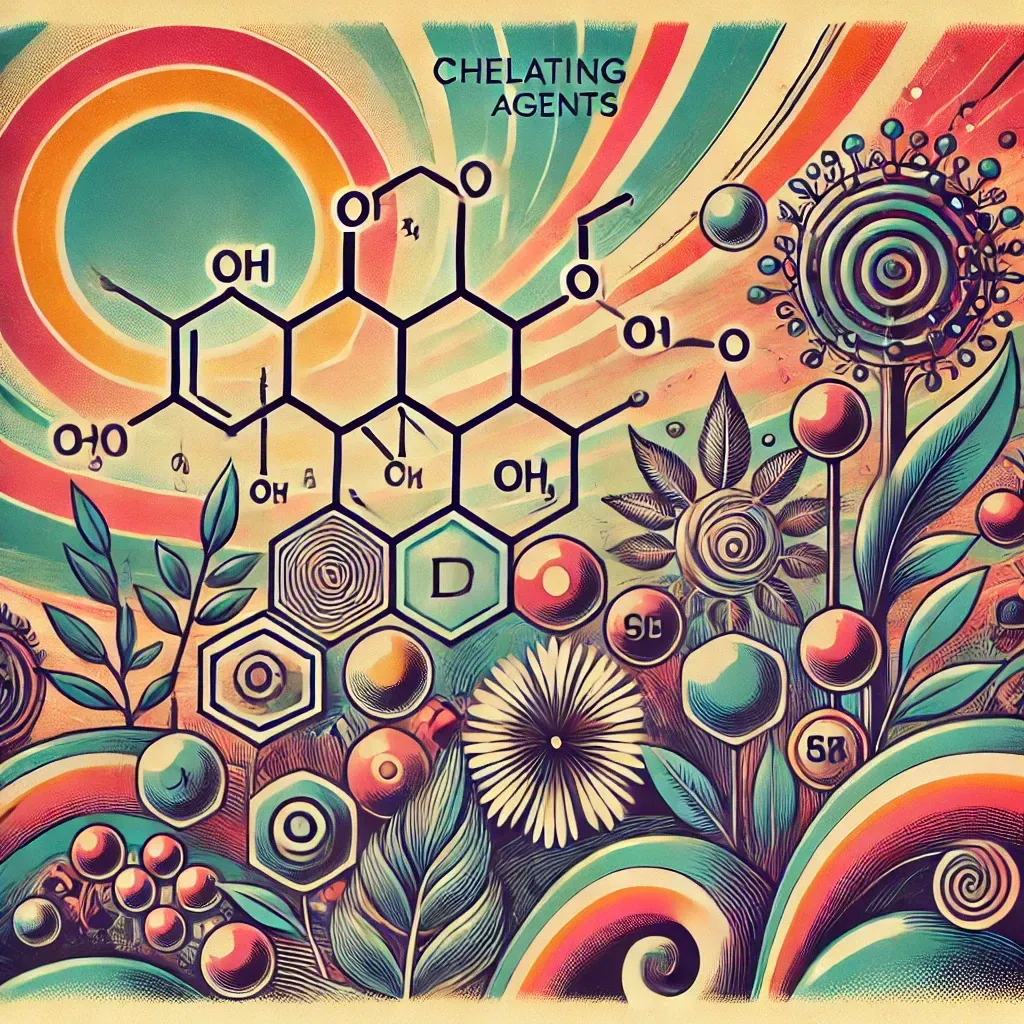Discover the variety of our chelator-infused skin care products that protect your skin from harmful metal ions while maintaining the effectiveness of your favorite products. Be inspired by our tailor-made solutions for your cosmetics brand! We at Chrambl are happy to advise you.

Chelators in cosmetics:
Protection and stabilization for your skin
In the world of cosmetics, chelators play an important role, even if they are often overlooked. These substances are crucial for the stability of formulations and protecting the skin from harmful metal ions. But what exactly are chelators, how do they work, and why are they essential in cosmetics? In this blog post, we take a close look at the importance of chelators in cosmetics and how they can help improve your skin health.
What are chelators?
Chelators are molecules that bind metal ions and thus neutralize their reactive properties. Metal ions such as iron or copper can cause oxidation and degradation in cosmetic products, which affects the effectiveness and shelf life of the products. In skin care, chelators prevent these metal ions from coming into contact with the skin and causing damage.
How do chelators work in cosmetic products?
Through their ability to bind metal ions, chelators protect not only the formulation itself but also your skin from potentially harmful reactions. This binding prevents the metal ions from reacting with oxygen or other molecules and thus leading to oxidation. At the same time, chelators help cosmetic products to remain stable for longer and maintain their effectiveness.
Benefits of Chelators in Skin Care
Protection against metal ions: Chelators prevent harmful metal ions from penetrating the skin and causing damage.
Longer shelf life: Products containing chelators are more stable and have a longer shelf life because they are protected from oxidative damage.
Improved effectiveness: By stabilizing the formulation, the effectiveness of the active ingredients is maintained, making skin care more effective.
use in cosmetics
Chelators are found in many skin care products, from cleansers to serums and masks. They are especially important in products that contain antioxidants because they prevent metal ions from breaking down these active ingredients. In hair care products, chelators help neutralize minerals from hard water, resulting in healthier, softer hair.
| Designation | INCI Name | area of operation | effect on the body |
|---|---|---|---|
| amino acid chelators | Amino Acid Chelates | Natural chelators, especially gentle for the skin | Protection against heavy metals, promotes healthy skin functions |
| Ascorbyl Glucoside | Ascorbyl Glucoside | chelator, antioxidant effect | Protects the skin from oxidative stress |
| Bisabolol | Bisabolol | Natural chelator, protects formulations | Soothes the skin and prevents reactions with heavy metals |
| Calcium Gluconate | Calcium Gluconate | Natural chelator, binds metal ions in care products | Strengthens the skin barrier and protects against metal ions |
| Calciumdisodium EDTA | Calciumdisodium EDTA | Increases stability of colors and fragrances | protection against metal ion oxidation |
| citric acid | Citric Acid | Binds metal ions, also acts as a pH regulator | Supports the skin barrier, protects against oxidation |
| diethylenetriaminepentaacetic acid (DTPA) | Pentasodium Pentetate | Prevents color changes and protects fragrances | Ensures stability of colors and fragrances |
| Dipeptide Diaminobutyroyl Benzylamide Diacetate | Dipeptide Diaminobutyroyl Benzylamide Diacetate | Chelator and peptide for cosmetic formulations | Stabilizes the skin and protects against metal ions |
| Dipotassium Glycyrrhizate | Dipotassium Glycyrrhizate | Chelator and soothing agent in cosmetic products | Relieves skin irritation and protects against metal ions |
| Disodium Succinate | Disodium Succinate | Chelator and antioxidant in cosmetic products | Prevents the reaction of heavy metals |
| EDDS | Ethylenediamine Disuccinate | Biodegradable chelator | Environmentally friendly, protects the skin barrier |
| ethylenediaminetetraacetic acid (EDTA) | Disodium EDTA | Stabilization of formulations, prevents oxidation | No direct effect on the body, ensures stability of the formulation |
| Ferulasäure | Ferulic Acid | Natural chelator, protects formulations from oxidation | Strong antioxidant, protects the skin from free radicals |
| Gluconodialdolacton | Gluconodialdolactone | Natural chelator in cosmetic formulations | Prevents skin damage caused by heavy metals |
| Glucosamine | Glucosamine | chelator and moisturizer | Prevents damage caused by metal ions and moisturizes |
| glutamic acid | Glutamic Acid | Binds heavy metals, antioxidant effect | Protects the skin from free radicals |
| hydroxymethanesulfonic acid | Hydroxyethyl Cellulose | Binds metal ions, prevents oils from becoming rancid | No direct effect, protects the formulation |
| Lactobionic acid | Lactobionic Acid | Acts as a chelator and humectant | Protects the skin, moisturizes |
| Methylglycin-Diacetat | Methylglycine Diacetic Acid | Biodegradable chelator | Environmentally friendly, protects the formulation from metal ions |
| sodium salt of ethylenediaminetetraacetic acid | Sodium EDTA | Prevents limescale deposits and increases product stability | Prevents skin irritation by neutralizing metal ions |
| oxalic acid | Oxalic Acid | chelator in cosmetics and cleaning products | Protects the skin from metal ion exposure |
| phosphonic acids | Aminotris(methylenephosphonic acid) | Chelator, prevents deposits in formulations | Stabilizes cosmetic products, protects against color changes |
| phytic acid | Phytic Acid | Natural chelate, binds heavy metals in formulations | Natural antioxidant effect, protects the skin from metal ions |
| polyphosphoric acids | Sodium Polyphosphate | Acts as a metal ion scavenger in washing and care products | Stabilizes the formulation and protects the skin from metal ions |
| Propylen Glycol Dicaprylate/Dicaprate | Propylen Glycol Dicaprylate | Chelator, increases stability of the formulation | Protects the skin barrier from metal ions |
| salicylic acid | Salicylic Acid | Chelator, prevents the deposition of metal ions | Protects the skin from free radicals and metal ions |
| Sodium Bicarbonate | Sodium Bicarbonate | Chelator, neutralizes metal ions in cleaning products | Protects the skin from irritants and metal ions |
| Sodium Citrate | Sodium Citrate | Acts as a chelator and pH stabilizer | Protects the skin from oxidative stress and neutralizes acids |
| Sodium Gluconate | Sodium Gluconate | Binds metal ions, regulates pH value in care products | Prevents damage caused by heavy metals, protects the skin |
| Designation | INCI Name | area of operation | effect on the body |
|---|---|---|---|
| Sodium Phytate | Sodium Phytate | Natural chelator in skin care products | Protects the skin from free radicals and metal ions |
| Sodium Thioglycolate | Sodium Thioglycolate | Prevents the reaction of heavy metals in formulations | Neutralizes heavy metals and protects the skin |
| Tetrasodium EDTA | Tetrasodium EDTA | Prevention of metal ion reactions in products | Stabilizes products and protects against premature decomposition |
| Tetrasodium Phosphonate | Tetrasodium Phosphonate | chelator and pH stabilizer | Protects formulations from heavy metal reactions |
| Tocopherolacetate | Tocopheryl Acetate | chelator, antioxidant effect | Protects the skin from oxidative stress |
| Trisodium NTA | Trisodium NTA | Binds metal ions, acts as an antioxidant | Prevents skin damage caused by metal ion binding |
| zeolite | Zeolite | Natural chelator, binds heavy metals in skin products | Helps cleanse the skin of toxins |






